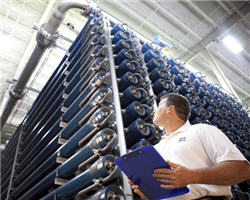Cherokee Marsh, it's called, this sunken enclave surrounded by cattails and bulrushes. The marsh is a mere dot on a map of the state of Wisconsin, but its importance reaches far beyond the wetland's edge.
Global demand for meat, milk and eggs has tripled in the past four decades and is expected to double by 2050. Increased global livestock production has great impacts on the environment and increases global warming. A major new European research project at the University of Copenhagen aims to identify and develop innovative solutions and technologies to handle and utilise the huge quantities of animal waste from livestock production. In Denmark, 34 million tons of animal manure are produced annually.
During some winters a significant amount of snow falls on parts of California. During other winters — like this one (so far) — there is much less snow. But more than 130 years of snow data show that over time snowfall in California is neither increasing nor decreasing.
University of California, San Diego electrical engineers are building a forest of tiny nanowire trees in order to cleanly capture solar energy without using fossil fuels and harvest it for hydrogen fuel generation. Reporting in the journal Nanoscale, the team said nanowires, which are made from abundant natural materials like silicon and zinc oxide, also offer a cheap way to deliver hydrogen fuel on a mass scale.
Developed following the earthquake in Japan in March 2011, the protocol can be used to evaluate ability of filters to reduce radioactive iodine from water. Activated carbon, ion exchange and reverse osmosis technologies certified to new NSF/JWPA protocol can effectively reduce radioactive iodine from drinking water.
UN Secretary-General Ban Ki-moon said it is “a great achievement for the people of the world” and one of the first Millennium Development Goal targets to be achieved.
American households waste more than one trillion gallons of water each year due to leaky pipes, toilets, showerheads and other fixtures, but fixing leaks can be easy and inexpensive. During the 4th annual Fix a Leak Week, March 12-18, the U.S. Environmental Protection Agency’s (EPA) WaterSense program is educating Americans about the importance of fixing leaks around the home, which will save water and nearly 10 percent on utility bills.
The report released Feb. 28 by researchers from the Indiana University School of Public and Environmental Affairs and the IU European Union Center is being cited by the American Chemical Council as proof REACH won’t work well in the US.
Fuel economy edges to record high as carbon pollution levels drop to new low.
More than 99 percent of Antarctic blue whales were killed by commercial whalers during the 20th century, but the first circumpolar genetic study of these critically endangered whales has found a surprisingly high level of diversity among the surviving population of some 2,200 individuals.
Scientists at the U.S. Geological Survey have, for the first time, demonstrated how aquifer composition can affect how excessive levels of phosphorous (an essential nutrient contained in fertilizers) can be carried from fertilized agricultural fields via groundwater to streams and waterways. This finding will allow for more informed management of agriculture, ecosystem, and human water needs.
In a blow to fiscal responsibility and river protections that Americans hold dear, the House of Representatives today voted to allow the construction of a $700 million mega-bridge over the Wild and Scenic St. Croix River. The bill had already passed the Senate.
Agencies publish environmental justice strategies designed to ensure that all communities are protected from environmental harm and benefit from federal programs
The Groundwater Replenishment System expands its capacity to purify wastewater.
An accurate new way to measure a potent greenhouse gas emitted during agricultural production will help countries to better manage their environmental impact, thanks to Queensland University of Technology (QUT) research.
The nation's electric grid isn't something most of us think about very often, except when an event such as the infamous 2003 blackout in the northeast takes place.
Before wastewater reaches recipient waters, nutrients must be removed in order to avoid eutrophication and large algal blooms, which may result in serious damage to animal and plant life. Robert Almstrand at the Depertment of Chemistry and Molecular Biology at the University of Gothenburg, Sweden, has shown in his thesis that better removal of nitrogen from wastewater can be achieved by providing the bacteria that purify the water with alternating high and low levels of nutrients.
The grant for $234,713, given to the Oklahoma Department of Labor (ODOL), will be used for inspections and encouraging compliance with the Asbestos in Schools Program which is designed to protect the health of school children and other occupants as well as the community.
The costs to switch to numeric criteria for limiting nutrient pollutants in Florida waters are expected to exceed U.S. Environmental Protection Agency (EPA) estimates, says a new National Research Council report.

As the world population grows, the struggle to provide enough resources to people becomes paramount. Whether it is having access to a resource or having enough of it, nations will fight to gain control of supply. Of those resources, one of the most vital is water.